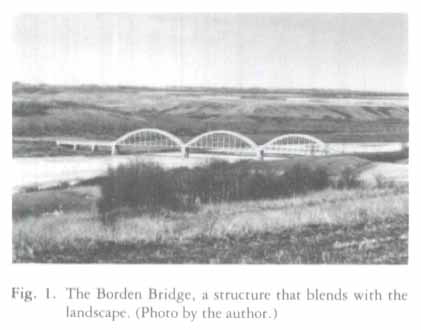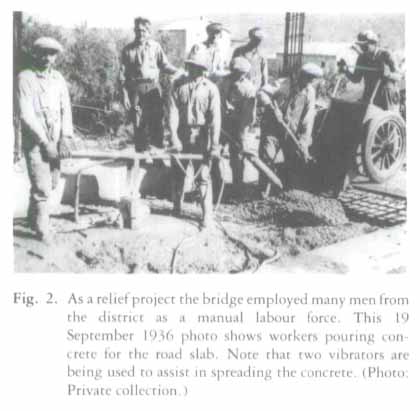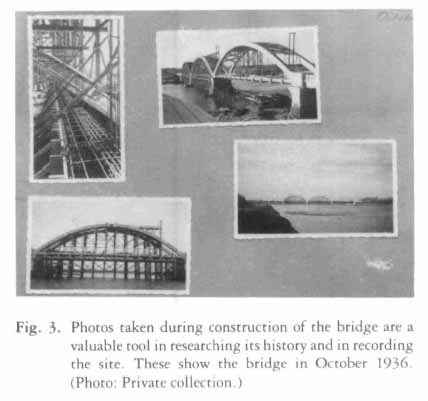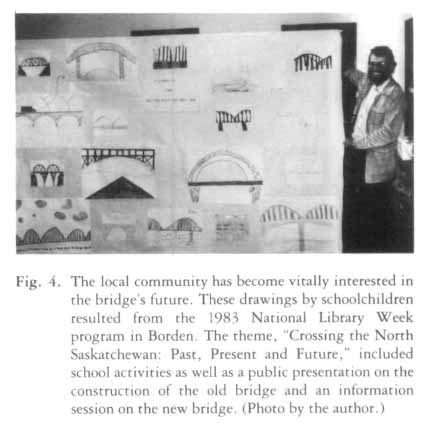Research Reports / Rapports de recherche
Dealing with an Industrial Monument:
The Borden Bridge
Introduction
1 The Borden Bridge is a concrete bowstring arch bridge spanning the North Saskatchewan River fifty kilometres northwest of Saskatoon. Built during 1935-36, the bridge has both engineering features and local importance that make it a significant industrial heritage site.
2 The concrete bowstring arch bridge was a structural form widely used on Canadian highways from about 1909 until World War II. Most of the spans were less than 150 feet. Possibly the last of this type constructed in Canada, the Borden Bridge with its 213-foot centre span has the distinction of being one of the longest concrete bowstring arch bridges on floating foundations in the world. Designed under the supervision of Chalmers Jack Mackenzie, then Dean of Engineering at the University of Saskatchewan and later President of the National Research Council and Atomic Energy of Canada Limited, the bridge represents an important achievement by this famous Canadian engineer. Since the bridge design was undertaken at the university it became the subject of additional research by students; this work included photoelastic stress testing, an early application of this technology to structures testing.
3 On a more local level, the bridge is significant for the people of the area. The bridge site was originally known as the Ceepee ferry and the contract documents issued by the Department of Public Works listed the project as the Ceepee Bridge. However, N.S. Smith, then the enthusiastic mayor of Borden and a prominent local Liberal, managed to convince federal politicians that the bridge should be renamed for the town. (The town itself had been named after Sir Frederick Borden, Minister of Militia in Sir Wilfrid Laurier's cabinet.) Built during the Depression, the bridge was one of many construction projects initiated by the federal and provincial governments to provide unemployment relief. Many people in the area participated in construction of the bridge and it has always had local importance, reflecting the pride of its builders.
 Display large image of Figure 1
Display large image of Figure 14 Finally, and perhaps the most pressing reason for initiating study of the bridge, is the construction of a new crossing at the site and the planned abandonment of the original bridge. The bridge's future is uncertain and research work is needed to preserve the story of its design, construction, and contribution. A local group is currently soliciting support for designation of the bridge as a provincial heritage site. A report describing its historical and engineering significance is in preparation and will support the submission to the provincial Minister of Culture and Recreation. Copies were made available to interested groups in the autumn of 1984. A more comprehensive article is planned for the spring of 1985.
 Display large image of Figure 2
Display large image of Figure 2The Project
5 The researching of a unique in-place engineering artifact presents the historian with work in a relatively new discipline — industrial archaeology — and with a different approach to an historical object. The artifact cannot be easily adapted to interpretation; it is impossible to move it to a central location for display, and neither museums nor architectural preservation groups have a tradition of working with such items.
6 R.A. Buchanan, an early promoter of industrial archaeology, summarizes the main purposes of the discipline as follows: "Industrial archaeology is a field of study concerned with investigating, surveying, recording and, in some cases, with preserving industrial monuments. It aims, moreover, at assessing the significance of these monuments in the context of social and technological history."1
7 The investigation of an "industrial monument" is necessary to learn its history and thus allow assessment of its contribution and significance to the development of the region and technology. The site survey records the artifact's nature and remains and ensures that a record of its existence is created. The recording of the site consists of presentation of findings on the artifact to those audiences with an interest in the site and can provide some incentive for its eventual preservation, if this is warranted. With these purposes in mind it is possible to approach the subject with a planned strategy.
8 Investigating the history of the Borden Bridge was an interesting subject which covered a broad range of resources including technical literature, departmental files, archival materials, and personal interviews. Each source contributed different but complementary information to the researcher.
9 The Engineering Journal, the journal of the Engineering Institute of Canada, and Canadian Engineer, a weekly summary of engineering work in the country, were the major technical periodicals studied. They provided the basic technical information on the bridge and its construction. The major article about the bridge supplied a schedule of the construction process and noted the special conditions found at the site.2 With this information it was possible to analyze the bridge's design. What was unusual about it? What was typical? This type of assessment is critical in any artifact evaluation. In addition to this site-specific data, a review of the journals placed the project in the context of other major construction and relief projects undertaken in western Canada during the mid-thirties. This approach also assisted in evaluation of the structure. The review of the technical literature was a valuable starting point for investigation of the bridge. By providing a calendar of events and specific technical information and by placing the project in the larger context of the Depression, the review allowed further research to focus on the artifact's special character.
10 The second major source used to investigate the bridge was the correspondence files of the Saskatchewan Department of Highways and Transportation, Bridge Division. The files are organized by structure and contain all correspondence relating to a particular river crossing. The Borden Bridge file included material back to 1917 when the Saskatoon Board of Trade first requested construction of a bridge to encourage trade and development. Calls for a bridge and complaints about the ferry service continued through the twenties. The design of a steel bridge and its shelving due to the financial constraints of the Depression is also revealed. Correspondence relating to construction of the bridge under the Relief Act by the Federal Department of Public Works reflects the acrimonious relations between the federal and Saskatchewan governments that characterized the period. Especially important is information showing how contemporary relief requirements affected the design and led to construction of the concrete arch bridge.
11 As the work was a labour-intensive relief project, there is a rich oral tradition in the surrounding area dealing with its construction. Interviews with a number of people involved with the bridge erection revealed a great deal about life at the isolated construction site. Participants gave information on meals, wages, buildings on the site, and amusements available to workers. Another important matter was to determine the economic and social effects of the relief project. Did the construction provide relief and to whom? What effect was felt in surrounding communities? A great deal of information on manual and horse-drawn building methods was also collected. The relief projects of the Depression were probably the last construction works done using these techniques. Perhaps the most important aspect of the oral investigation was access to private photo collections. Photos supplied useful details on the construction camp and erection of the bridge. They were also very helpful in refreshing memories during oral interviews. The oral investigation provided valuable data about site features that have either disappeared or been altered and helped establish the local significance of the artifact.
12 Archival research played only a small part in the site investigation. However, it did supply some gems. In the University of Saskatchewan Archives, a Master of Engineering thesis describing the design of the Borden Bridge was found. This piece highlighted the design process.
13 With the historical investigation largely complete, the researcher has created a comprehensive background against which to place the artifact. The Borden Bridge emerges as an important engineering achievement, perhaps the ultimate example of the large concrete bowstring arch type. The bridge also reflects the region's history. It indicates the growth of the prairie road transportation network and adds to the history of the Depression. With this information the bridge's historical and engineering significance can be established.
 Display large image of Figure 3
Display large image of Figure 314 The site survey had two parts: measurement of the bridge and its modifications and recording of the no longer extant construction camp. The bridge is very well documented. The Bridge Branch of the Saskatchewan Department of Highways and Transportation maintains a permanent copy of the building plans and has complete files noting the limited modifications and additions that have affected it. The transient nature of the construction camp, which existed for only about one year, has meant that little has been found to document its layout. It included engineers' quarters, blacksmithing facilities, a small power plant, and dining and sleeping accommodation for a crew of about 100. Only a few photos showing the camp have been collected, while the few surface traces remaining have been obliterated by construction of the new bridge.
 Display large image of Figure 4
Display large image of Figure 415 Recording of the artifact has begun. Presentation of the historical data to a local audience has prompted interest in the structure as a heritage piece. A more extensive article is in preparation to bring the artifact to a larger professional audience. Finally, it is hoped that both the preceding activities and the present article will encourage interest in the heritage of our country, perhaps the most important function that any artifact can perform.
16 The final responsibility of industrial archaeology is preservation of the significant artifact. The fate of the Borden Bridge is still unknown. The historical data make a good case for its preservation as an important artifact. However, large in-place engineering structures such as a bridge are impossible to treat as usual museum acquisitions. In Ontario, the Ministries of Transportation and Communications and Citizenship and Culture have addressed this problem and created heritage criteria and a scale of options to minimize the loss of heritage bridges. The heritage criteria include items such as the age and construction material of the structure, information on the designer, the typicality of the design, and the visual and historical importance of the structure to the local environment. The preservation options run from "maintenance and/or strengthening of a bridge without significant material change to its visual appearance" to "a graphic and verbal display of the former structure utilizing information collected in the recording and detailed documentation mitigation measure."3 The possibilities for the Borden Bridge are only beginning to be explored at this time, but some form of recognition for the structure appears to be appropriate.